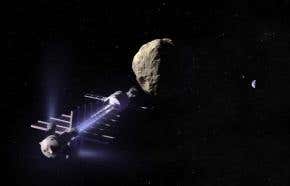steve_bank
Diabetic retinopathy and poor eyesight. Typos ...
It is an expensive demonstration of Newtonian mechanics.
If the velocity of the probe goes to zero then all the kinetic energy goes to the asteroid. The quetion is how much energy actually goes to deflection.
That will be measured over time which is the point of the experiment.
A good mass to hit the asteroid might be a flatt stff metal plate. Distribute the force over a large area and reduce fragmentation.
If the velocity of the probe goes to zero then all the kinetic energy goes to the asteroid. The quetion is how much energy actually goes to deflection.
That will be measured over time which is the point of the experiment.
A good mass to hit the asteroid might be a flatt stff metal plate. Distribute the force over a large area and reduce fragmentation.


